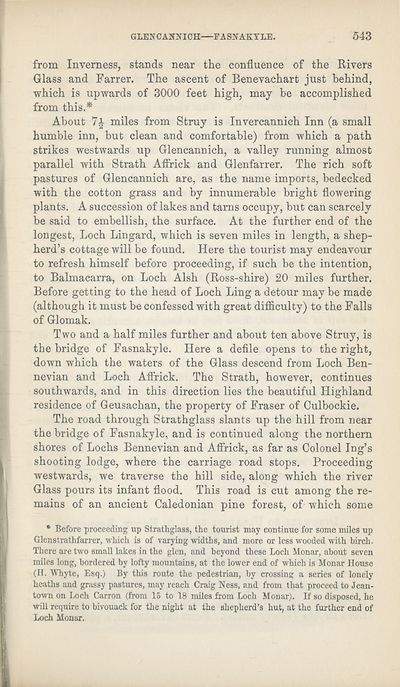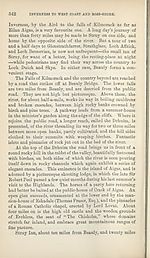Download files
Complete book:
Individual page:
Thumbnail gallery: Grid view | List view

GLENCANNICH—FASNAKYLE.
543
from Inverness, stands near the confluence of the Rivers
Glass and Farrer. The ascent of Benevachart just behind,
which is upwards of 3000 feet high, may be accomplished
from this.*
About 7| miles from Struy is Invercannich Inn (a small
humble inn, but clean and comfortable) from which a path
strikes westwards up Glencannich, a valley running almost
parallel with Strath Affrick and Glenfarrer. The rich soft
pastures of Glencannich are, as the name imports, bedecked
with the cotton grass and by innumerable bright flowering
plants. A succession of lakes and tarns occupy, but can scarcely
be said to embellish, the surface. At the further end of the
longest, Loch Lingard, which is seven miles in length, a shep¬
herd’s cottage will be found. Here the tourist may endeavour
to refresh himself before proceeding, if such be the intention,
to Balmacarra, on Loch Alsh (Ross-shire) 20 miles further.
Before getting to the head of Loch Ling a detour may be made
(although it must be confessed with great difficulty) to the Falls
of Glomak.
Two and a half miles further and about ten above Struy, is
the bridge of Fasnakyle. Here a defile opens to the right,
down which the waters of the Glass descend from Loch Ben-
nevian and Loch Aflrick. The Strath, however, continues
southwards, and in this direction lies the beautiful Highland
residence of Geusachan, the property of Fraser of Culbockie.
The road through Strathglass slants up the hill from near
the bridge of Fasnakyle, and is continued along the northern
shores of Lochs Bennevian and Afirick, as far as Colonel Ing’s
shooting lodge, where the carriage road stops. Proceeding
westwards, we traverse the hill side, along which the river
Glass pours its infant flood. This road is cut among the re¬
mains of an ancient Caledonian pine forest, of which some
* Before proceeding up Strathglass, the tourist may continue for some miles up
Glenstrathfarrer, which is of varying widths, and more or less wooded with birch.
There are two small lakes in the glen, and beyond these Loch Monar, about seven
miles long, bordered by lofty mountains, at the lower end of which is Monar House
(H. Whyte, Esq.) By this route the pedestrian, by crossing a series of lonely
heaths and grassy pastures, may reach Craig Ness, and from that proceed to Jean-
town on Loch Carron (from 15 to 18 miles from Loch Monar). If so disposed, he
will require to bivouack for the night at the shepherd’s hut, at the further end of
Loch Monar.
543
from Inverness, stands near the confluence of the Rivers
Glass and Farrer. The ascent of Benevachart just behind,
which is upwards of 3000 feet high, may be accomplished
from this.*
About 7| miles from Struy is Invercannich Inn (a small
humble inn, but clean and comfortable) from which a path
strikes westwards up Glencannich, a valley running almost
parallel with Strath Affrick and Glenfarrer. The rich soft
pastures of Glencannich are, as the name imports, bedecked
with the cotton grass and by innumerable bright flowering
plants. A succession of lakes and tarns occupy, but can scarcely
be said to embellish, the surface. At the further end of the
longest, Loch Lingard, which is seven miles in length, a shep¬
herd’s cottage will be found. Here the tourist may endeavour
to refresh himself before proceeding, if such be the intention,
to Balmacarra, on Loch Alsh (Ross-shire) 20 miles further.
Before getting to the head of Loch Ling a detour may be made
(although it must be confessed with great difficulty) to the Falls
of Glomak.
Two and a half miles further and about ten above Struy, is
the bridge of Fasnakyle. Here a defile opens to the right,
down which the waters of the Glass descend from Loch Ben-
nevian and Loch Aflrick. The Strath, however, continues
southwards, and in this direction lies the beautiful Highland
residence of Geusachan, the property of Fraser of Culbockie.
The road through Strathglass slants up the hill from near
the bridge of Fasnakyle, and is continued along the northern
shores of Lochs Bennevian and Afirick, as far as Colonel Ing’s
shooting lodge, where the carriage road stops. Proceeding
westwards, we traverse the hill side, along which the river
Glass pours its infant flood. This road is cut among the re¬
mains of an ancient Caledonian pine forest, of which some
* Before proceeding up Strathglass, the tourist may continue for some miles up
Glenstrathfarrer, which is of varying widths, and more or less wooded with birch.
There are two small lakes in the glen, and beyond these Loch Monar, about seven
miles long, bordered by lofty mountains, at the lower end of which is Monar House
(H. Whyte, Esq.) By this route the pedestrian, by crossing a series of lonely
heaths and grassy pastures, may reach Craig Ness, and from that proceed to Jean-
town on Loch Carron (from 15 to 18 miles from Loch Monar). If so disposed, he
will require to bivouack for the night at the shepherd’s hut, at the further end of
Loch Monar.
Set display mode to:
![]() Universal Viewer |
Universal Viewer | ![]() Mirador |
Large image | Transcription
Mirador |
Large image | Transcription
| Antiquarian books of Scotland > Scotland/Scots > Black's picturesque tourist of Scotland > (677) |
|---|
| Permanent URL | https://digital.nls.uk/130036314 |
|---|
| Description | Thousands of printed books from the Antiquarian Books of Scotland collection which dates from 1641 to the 1980s. The collection consists of 14,800 books which were published in Scotland or have a Scottish connection, e.g. through the author, printer or owner. Subjects covered include sport, education, diseases, adventure, occupations, Jacobites, politics and religion. Among the 29 languages represented are English, Gaelic, Italian, French, Russian and Swedish. |
|---|

